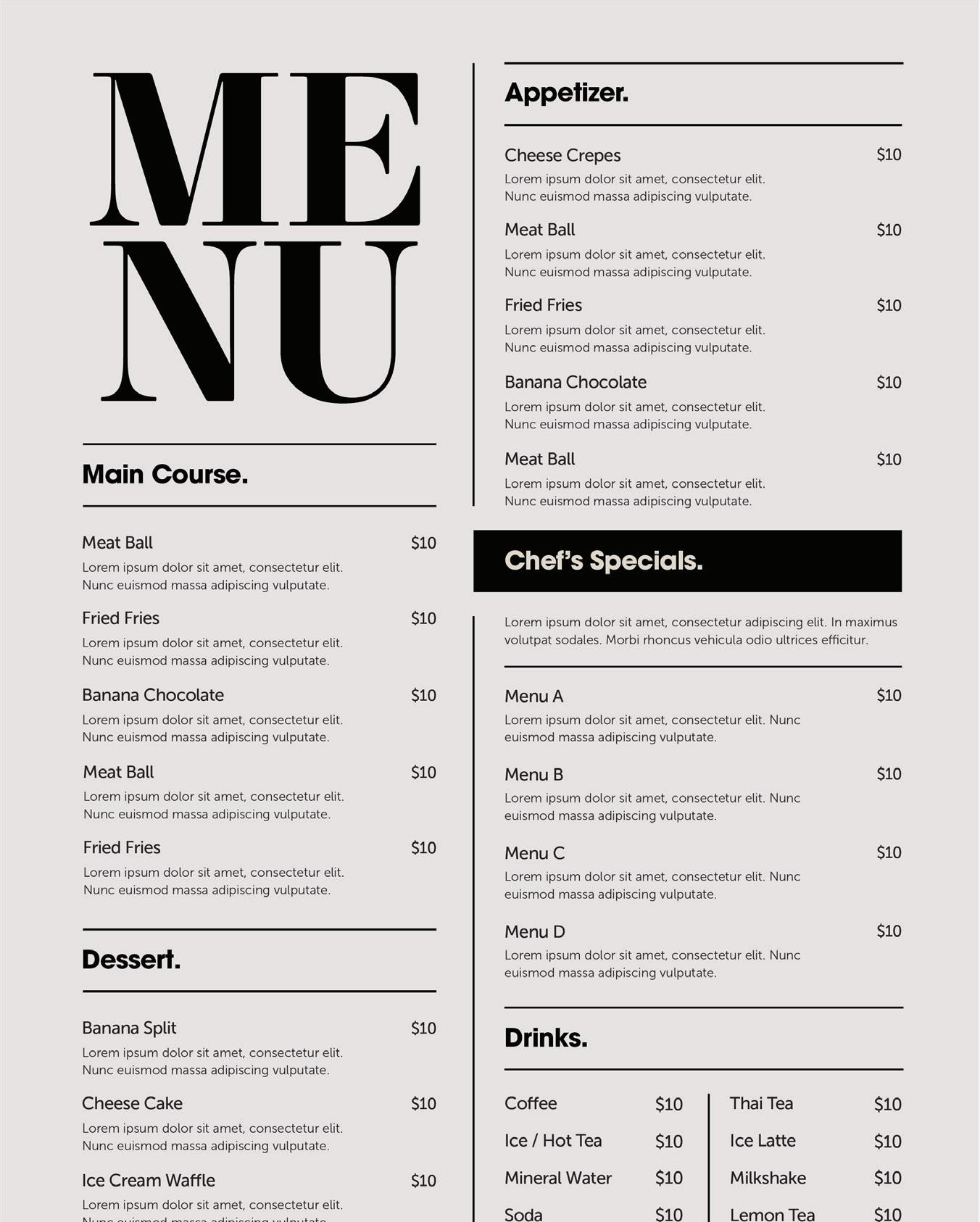
10 minute read
How to Raise Menu Prices the Right Way
Article by Jillian Henze, Senior Communications Manager at Washington Hospitality Association
Raising menu prices can be scary because of the worry that your restaurant will lose customers. Our experts recommend how to raise menu prices the right way.
Advertisement
It’s an art and science
Washington State's Hospitality Association President and CEO Anthony Anton combines numbers with what he observes about customers.
“Menu pricing is combining art and science,” Anton said.
He recommends calculating the percentage you need to increase menu prices and using some key observations about your customers to decide where to make the increases.
For example, at a casual, full-service restaurant with regular weekly customers, those customers are not highly aware of the beverage or dessert prices, Anton said. But, the customers are paying close attention to the prices of the appetizers and entrees.
The art would be to raise prices where the customer’s awareness is lower, he said.
“Look artistically at how to move that percentage around in different areas,” Anton said.
And make sure to keep an eye on the competition. Identify similar restaurants in the area customers would choose instead of your restaurant, and evaluate their menu prices, Anton said.
“What are your customers choosing instead of you?” he asks.
Excel and Quickbooks are tools to help you with basic menu pricing, Anton said. Your supplier may have software or a consultant to help, though he cautions that the supplier’s software may only include recipe items you purchase from that supplier.
Anton said if he were running a restaurant today, he would change menu prices two to four times per year. Why? Things are changing faster than ever before, and because you don’t want customers to get attached to a price point, he said.
Plus, like muscle memory, doing the calculations daily or weekly will make it more familiar and easier for you. Tracking numbers like food cost, labor cost and other expenses (utilities, administrative costs, etc.), will help you stay on top of change, and will help you protect your margins more vigorously, Anton said.
Play with percentages
Here is how David Jones from Blazing Onion and Subway restaurants prices a menu from scratch.
1.
2.
3.
4. Jones said to start, each manager takes their average employee hours schedule and plugs in total cost of current wages for a week. Then the regional manager, the general manager and Jones sit and discuss new wages. New wages are plugged into the schedule to discover the increase in weekly labor cost. Next, the regional manager pulls up a menu mix report (can also be called a food cost report) for an average week and drops it into a spreadsheet with the restaurant’s latest menu prices. Jones said he will play with numbers in his spreadsheets by plugging in a menu price percentage increase, rounding up or down until he makes up for the labor cost gap.
Jones said that increasing menu prices too much can cause a major hit on customer traffic, while raising prices too little can cause an unsustainable loss in profit.
“That will creep up on you and show its face on a delayed schedule, mainly because accounting reports and P&L’s come delayed, which kills you,” Jones said. “You just increased prices, you can’t increase again so soon, so now what do you do? Strategize.”
Focus on dollars
Chris Patterson, the business solutions director at Food Services of America Spokane, said he recommends clients first find out what the wage hike will cost. 1. Calculate the increase in labor cost. 2. Then, do some “menu mapping,” he said. Some calculators or accountants would recommend a menu price increase percentage (for example, you’ll need to raise your menu prices by 3.6 percent in 2020). But, Patterson prefers to do the math with real dollars, he said. That 3.6 percent menu price increase in the calculator was necessary because the wage increase and other items equal a dollar increase of $36,022.50 in 2020. 3. “Break it down into a daily total so your head doesn’t start swimming,” Patterson recommended. So, divide $36,022.50 by how many days the restaurant operates (364 days of the year for example), and you are left to increase revenues by $98.96 per day.Next, go into your POS terminal, or check your Excel spreadsheet where you keep your sales data, and grab numbers from the past three or six months.
Write down how many of each menu item was sold on one side of a sheet of paper (this will show your most popular dishes). Then write down the gross profit for each dish on the other side of the paper (this will show you your most profitable dishes). To generate the extra $98.96 per day, raise the price on the most popular dishes for a greater impact, Patterson said. From there, evaluate if and how much you need to raise prices on the most profitable dishes.
“If you raise prices on only the most popular 10-15 dishes, there’s an opportunity to say, ‘I did have to raise my prices (you all know why), but only on some of my menu items,’” he said.
With many clients, he showed them an across-the-board 3 percent menu price increase was unnecessary, Patterson said. Translating the percentage into a dollar amount can help you see this, and doing so can make the increases feel more manageable.
What to say to a customer who remarks on your increased prices
Anton said he likes the way the California Restaurant Association frames it: “On average, for every $1 spent eating in the USA, about 95 cents goes to food, the place and a GREAT staff!”
He said the message is a nice way to let customers know you have less than a 5% profit margin.
Increasing menu prices more regularly will lessen the fear of what customers will say, Anton adds.



“You can’t stay in business if you lose money on every sale,” he said. “You can’t make it up on volume. Charge what you need to charge to stay in business and provide good jobs for your team.”
Trends Defining How People Will Eat in the New Decade

The 2010s have been marked by avocado toast, kale, plant-based meat alternatives, and recently, cult-favorite fast-food chicken sandwiches.
But with a new decade just around the corner, what’s the next big thing we should expect in food?
To find out, Insider spoke with Hudson Riehle, the senior vice president of research at the National Restaurant Association, and Allan Sherwin, a professor of culinary management at Michigan State University.
There will be an increased interest in “locavore” eating in 2020.
Sherwin said locavore eating will continue to grow in popularity in the new year. Someone who follows a locavore diet or who identifies as a locavore focuses on eating foods that are made with locally grown ingredients or that have been sourced from local farms. raised’ and organic,” he said. “That will continue to be an important consideration for people in the coming year.”
More restaurants will embrace open-concept kitchens as customers want to see how their food is being made.
Sherwin predicted that restaurants will continue to embrace open-concept designs that show guests how they’re preparing food.
“More and more, people want to see how the food is being made,” Sherwin said. “They want to feel like they’re a part of the experience, not just tucked away having their food magically brought to them.”
It will be more common to find kids’ menus that feature whole-grain superfoods like quinoa, as well as global cuisine.
“We’re predicting more availability of healthy items on children’s menus that allow kids to explore new flavors,” Riehle said. “We can expect to see kids’ menus incorporating more global flavors — from Mediterranean cuisine to West African dishes.”
Riehle added that more restaurants are crafting kids’ menus that focus on whole grains like quinoa and wholewheat breads, rather than simple carbs like white bread, which offer little nutritional value.
Fermented beverages and non-alcoholic drinks will also be all the rage in the upcoming year.
Sherwin highlighted the drink kombucha — made of fermented yeast and often thought of as having health benefits that aid gut health — as a buzzy beverage option for the upcoming year.
“People are spending more on kombucha and kombucha-like beverages,” Sherwin said. “They’re not adverse to spending $10 to $15 for one of these drinks because of their supposed health benefits.”
Korean rice liquor, known as makgeolli, will also be a trendy drink in 2020. Sherwin, whose area of expertise is in food and beverage studies, predicted the Korean drink makgeolli will be gracing many restaurant and bar menus in 2020.
The milky-white drink is slightly sparkling and tastes both sweet and sour.
Biodynamic wine will grow in popularity in 2020.
Sherwin is currently coaching a team of students who are creating a wine as part of a collegiate competition, and his team’s product is a biodynamic wine — which he says is part of a growing trend.
Wine — or any crop or product — made with a biodynamic method means it has met a certain set of standards for being grown without pesticides and unnatural processes or chemicals.
Sherwin added that biodynamic wine tends to refer to grapes that have been planted and grown at certain times of the season that relate to the moon phases.
“Ten years ago, somebody would say, ‘You’re out of your mind’ if you said there’s a wine where the grapes are grown according to the phases of the moon,” Sherwin said. “But today, I think people are willing to spend more money on a glass if they think it’s more beneficial or unique.”
The zero-waste movement will influence the food and restaurant industry.
Composting and avoiding purchasing foods with excess or wasteful packaging are all ways that home cooks and restaurant chefs will be incorporating the zero-waste trend into the kitchen in 2020.
“Zero-waste cooking is a sign of the times, as younger generations of consumers value that in restaurants and want to support establishments that are more ecofriendly,” Riehle said. “It’s also good for business and helps restaurants reduce costs, as well as benefiting the environment.”
The popularity of home meal kits with pre-measured ingredients will continue in 2020.
Sherwin attributed his prediction about the growing popularity of home meal kits — such as Blue Apron, HelloFresh, and a variety of other kit brands — to the fact that many Americans eat at “unconventional” times but still want restaurant-quality meals.
“Many people are no longer eating lunch right at noon or dinner at 6,” he said. “They’ll eat dinner later, maybe breakfast later, and maybe it changes every day. Meal kits make people’s lives easier by cutting down time on food prep, but still make for a hearty lunch or dinner.”
Restaurants will expand menu options for takeout and delivery.
“Takeout no longer centers only around pizza and fast food,” said Riehle. “Traffic and meal occasions are becoming more and more centered around the restaurant — and not just a small, select menu — coming to consumers.”
Over the past 60 years, Americans’ spending on food has consistently shifted toward restaurant spending, according to Riehle.
He said he doesn’t expect that to change in 2020, with people’s digital lives leading them to value even more the social aspect of dining at a brick-and-mortar restaurant.
“There are two reasons people go to a restaurant: convenience and socialization,” Riehle said. “While there is a long-term trend of restaurants coming to consumers and people having more meal occasions centered around delivery or takeout, people do still crave being at a physical restaurant for being around other people, for that atmosphere you can’t recreate at home, and for special occasions.”
Article reprinted from Insider.com.





